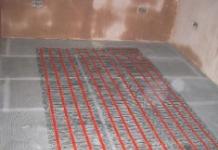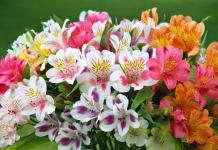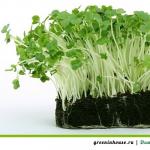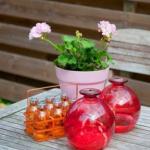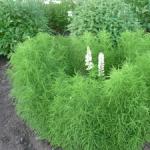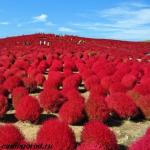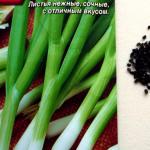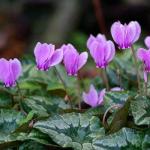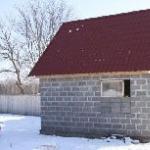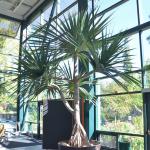Pelargonium is a prominent perennial that gardeners love and are used in interesting landscape designs around the world. At the same time, this plant comes from South Africa.
Pelargonium is sometimes called geranium, due to their similarity.. Also, these two different plants are close relatives, since they are representatives of the Geraniev family.
This confusion over the names of these plants began in the 18th century. Then the Dutch botanist Johannes Burman proposed to separate them into two separate genera, but earlier scientist Carl Linnaeus erroneously combined them into a common group. The final decision was made by the Frenchman Charles Louis Laritier, who identified pelargonium as a separate genus.
Abroad, pelargonium has long been considered a plant that only wealthy aristocrats can afford to grow in their greenhouses. In our country, pelargonium for some time was not very popular..
We offer you to watch a video about how pelargonium differs from geraniums:
Similarities
By Carl Linnaeus, they were united by the similarity of the fruit box, which, after fertilization, resembled a crane's beak because of the retractable pistil. The stems of both plants are erect, and the leaves grow alternately and are covered with small hairs. Plants have a specific aroma, are easy to propagate and are unpretentious..
Differences
- Genetic difference, therefore it is impossible to get seeds from their crossing.
- Climatic features. Pelargonium is more thermophilic, and geranium can bloom even at 12 ͦС. This is due to their native habitat: pelargonium - South Africa, geranium - the Northern Hemisphere.
- External differences of flowers and their shades. Pelargonium flowers are combined into large inflorescences, while the corolla is irregular in shape - 2 larger petals and are located on top. Geranium flowers are solitary with 5-8 petals. Geranium flowers are not scarlet, and pelargoniums are not blue.
What does the plant look like?
Pelargonium is a representative of perennial herbaceous plants, it is sometimes possible to meet shrub species. Pelargonium grows from 30 to 80 cm. Upright stems with alternately growing leaves. In this case, the shape of the leaves will be different for each species - simple, palmately dissected, palmate.
Inflorescences are umbrella-shaped. The flowers of cultivated species are larger than wild ones and have 2 large upper petals and 3 smaller lower ones. Pelargonium has a peculiar aroma inherent in each individual species, for example, nutmeg, chocolate, citrus.
With the help of hybridization, aromas such as peach, lemon, cinnamon, pine, cedar, lilac flowers, rose, vanilla can be achieved.
Main types: names, description and photo
Currently there are about 280 pelargoniums. The most popular among gardeners are the following types.
Zonal
This species can be both small (about 10 cm) and large (up to 1 m). Flowers can be two or three colors. A feature of this species is that the petals may have a dotted pattern or a darker spot in the shape of an egg.
The shades of the inflorescences can be very diverse - all shades of red, as well as pink, white, cream, yellow, and even several colors.
Varieties of Zonal Pelargonium:
- Alice.
- Bolero.
- Flamenco.
- Connie.
- Fantasy.
Royal

The most whimsical and beautiful view. This species got its name for large flowers (up to 8 cm in diameter) with a non-uniform color, complemented by dark excretory spots or stripes, as well as with a wavy edge.
Varieties of Royal Pelargonium:
- Princess of Wales.
- Turkish.
We offer you to watch a video about Royal Pelargonium:
Angel

Small (up to 30 cm) plants with flowers similar to pansies. Less whimsical and continue to bloom all summer.
Varieties of Pelargonium Angel:
- Black night.
- Angelys Bicolor.
- Madam Lyal.
ivy

This species has a feature - dark green leaves resembling the shape of ivy leaves. Inflorescences are most often terry, while the color palette is represented by shades from milky to purple and red.
Varieties of Ivy Pelargonium:
- crock-o-day.
- ice rose.
Fragrant

The most fragrant species, because when touching double flowers and leaves, a persistent aroma is felt. In some varieties, the leaves may be corrugated. Flowers are often not very attractive - small in size and soft in color.
Varieties of Fragrant Pelargonium:
- Diamond (pineapple).
- Chocolate Mint (mint).
- Attar of Roses (rose).
Beneficial features
This plant has a large number of useful properties, therefore it is also used in medicine and cooking.
Most often, fragrant and pink pelargonium are used.
cooking
- Since many varieties of pelargonium have a pleasant aroma, their leaves and flowers are used in the preparation of compotes, added to vodka, brandy, frozen in ice, added and decorated with desserts.
- Antiseptic properties are used in jam preparations to prevent mold.
Medicine

Very caution should be used when treating children, avoiding ingestion.
Pensioners and people with chronic diseases should clarify the information with a doctor before using drugs that contain pelargonium.
Find out more about the medicinal properties of pelargonium and its use in traditional medicine.
All about reproduction
seeds
 Seeds are best sown at the end of winter (January-February). With an earlier planting, it is necessary to provide additional lighting so that the seedlings do not stretch much. Seeds are planted in prepared and moistened soil and sprinkled with a thin layer of 2-3 mm soil. The container or individual cup is best kept at room temperature in a bright place.
Seeds are best sown at the end of winter (January-February). With an earlier planting, it is necessary to provide additional lighting so that the seedlings do not stretch much. Seeds are planted in prepared and moistened soil and sprinkled with a thin layer of 2-3 mm soil. The container or individual cup is best kept at room temperature in a bright place.
At first, watering is carried out as needed and by spraying.. After the sprouts have appeared, water as a normal plant, avoiding contact with leaves and stems.
Pelargonium should be dived after the first true leaf appears. A plant grown from seeds will bloom in about six months.
houseplant care
Pelargonium refers to unpretentious plants.

Find out more nuances about caring for pelargonium at home at.
Growing at home, on the balcony and flower bed
- Gray mold on the leaves can appear from excessive watering. It is necessary to remove infected leaves, dry the plant and treat with a fungicide.
When the root system or root collar rots, most often the plant dies.
- With fungal diseases such as verticillium wilt and rust, preventive measures are taken before the dormant period with the help of fungicides.
- In the fight against whiteflies, mealybugs, aphids and thrips, insecticides are used and it is best to carry out the treatment indoors.
Pelargonium is a flowering plant that is suitable for both on the balcony and even in open ground. Beautiful flowers will delight the entire summer period, and the unique aroma will be present all year round.
The homeland of this plant is very far from here, in the Cape. The rocks of the Cape of Good Hope in August light up with bonfires of its bright red flowers. Herbivores bypass fragrant thickets, and people from local tribes, on the contrary, willingly dig healing roots and collect foliage. Geranium, a plant native to South Africa, has long since become its own in Russia. And even turned into a symbol of unhurried petty-bourgeois life.
Types and varieties of pelargoniums
Genus Pelargonium ( Pelargonium) belongs to the order Geraniaceae, family Geraniaceae. In southern Africa, there are up to 180 representatives of this odorous genus. Less than a dozen have taken root in the apartments:
- geranium zonal- a textbook example from Soviet textbooks of botany. It is found most often in houses, has a leaf with a crenate edge and bright, often red, white or pink flowers;
- fragrant geranium- has dissected light silver leaves with a very pleasant smell of citrus and mint. The flowers are small. The view is remarkable in that it is possible to breed varieties with the smell of both lilac or rose, and nutmeg, and even pepper. Bred for the needs of the perfume industry.

- royal, large-flowered geranium (P. grandiflora) - is distinguished by huge pom-poms of flowers. Leaves with teeth along the edges;

- ivy pelargonium- the collective name of ampelous species. Popular in Europe, used for garden arches and other flowering structures. Even more thermophilic than zonal;
- pelargonium-angel(Angel's Eyes) - a stunted hybrid of domestic geranium with wild African. Its flowers are like violets;

- pelargonium-unique- a hybrid of fragrant geranium and royal. Differs in strong aroma of leaves and large flowers;
- pelargonium-succulents are not yet common, but are valuable material for, for example, alpine slides. They began to cultivate relatively recently.
Pelargonium received the common name "geranium" from its fellow member of the Geranium family - Geraniumsilvaticum. A real, forest geranium is a frost-resistant perennial, an inhabitant of the forests of the middle belt and the taiga zone. And the southerner pelargonium freezes even in Tajikistan.
The appearance of a room (garden, zonal) geranium is a branched shrub. The plant is perennial, but more often cultivated as an annual, because the shoots of the current year bloom more abundantly.
The root system of pelargonium is fibrous, compact. Well developed and adapted to dry conditions.
The leaves are characteristically round in shape, with a darker reddish ring-shaped area. The venation is palmate. There are varieties with a white border on the leaves (for example, Madama Butterfly), they were popular in the 60s and were called "whitefly". Leaves can be completely purple in color.
The geranium inflorescence is an umbrella, its appearance is well known. Various varieties have both simple and dissected, or double flowers. The diameter of the flower is about 2 cm, and the entire inflorescence reaches 15 cm in diameter, and in the royal pelargonium - up to 20 cm. The main gamut of geranium colors is in the red spectrum, from maroon to white. Varieties with purple and lilac flowers have been bred. There are no yellow shades so far.
Boxes with ripening seeds resemble the head of a stork, hence the name of the genus - pelargonium, translated from Greek - "similar to a stork". In old Russian books on home economics, geranium was called "crane", or "crane nose".
Ripe fruits have a spirally twisted bundle that reacts to changes in humidity and temperature, unwinding and twisting like a spring. With the help of this tourniquet, geranium seeds are buried in the soil. In old textbooks on natural history, you can find a way to make a barometer from a geranium seed.
Pelargonium Care
Even a five-year-old toddler is able to take care of geraniums, the plant is so unpretentious.
Light Pelargonium loves. The best place for her is the southern windows. Only hardened plants endure direct sunlight, taken out of partial shade to direct rays, geraniums will get burned. Northern or tree-shaded windows are not for geraniums, the flower stretches in length and loses its aesthetic qualities, and also loses its immunity.
Temperature the one that is usually observed in our premises is suitable, i.e. room. The plant is not sensitive to overheating, but prolonged cooling below + 10 ° C will lead to reddening and shedding of leaves. It is noticed that the varieties with red flowers are the least cold-resistant, as they are closest to natural forms. For the winter, geraniums are transferred to dormant mode, transferred to a room with a temperature of 8-10 ° C, and reducing watering to low moisture.
Geranium is one of the few plants that easily tolerate drafts. The homeland of pelargoniums - the Cape of Good Hope - is famous for its winds, and the hardening of the plant is in the genes. Fresh air has a very good effect on flowering, so it is advisable to take geraniums to the balcony or garden for the summer.
Humidity need moderate. The plant tolerates drought more easily than waterlogging. Geranium categorically does not tolerate spraying, it can shed leaves and flowers. You need to water the flower with the expectation that the soil in the pot has time to dry out two centimeters deep. Drainage is a prerequisite for the well-being of the plant, stagnant water will immediately provoke rotting of the stem.
The soil- light, neutral, with the addition of sand 1:10. Peat in the substrate is undesirable, as it accumulates moisture. Ordinary soddy land, or a mixture of leafy and humus soil, is quite suitable for geraniums. Pelargonium can successfully grow right on the beds, where it reaches a decent size. So that the growth energy does not go into the leaf mass, it is advisable not to plant the plant in open ground, but to use boxes, flowerpots and other containers.
Vessel for pelargonium, you can take almost any. Often, for design purposes, geraniums are placed in old copper teapots, or hanging planters of a variety of materials. Most flowers will be if you plant geraniums in a not very spacious vessel made of natural material - wood or clay. If the capacity is large, then several geraniums will look beautiful. They do not compete with each other at all, and bloom profusely, forming a picturesque group.
Transplant and pruning produced at the same time. It is best to do these manipulations when the day noticeably goes to profit, i.e. in February. Transplanted into a container, the same in volume, or a little more. In most cases, it is enough to replace the top layer of the earth. The plant is buried in the soil by 1-2 centimeters to stimulate the development of additional roots.
Cut off the main trunk, leaving three or four buds. Subsequently, young shoots will develop from them, which should also be pinched to give the plant a compact appearance. Geranium easily tolerates all operations for the formation of a bush. Abandoned old branches may not bloom at all, or bloom poorly. The resulting cuttings can be used as planting material.
Fertilizer the entire active period must be entered. From the very beginning of the growing season, it is advisable to slightly increase the dose of potassium so that flower buds start in the right amount. Then use standard complexes for flowering plants, in accordance with the norms on the package.
reproduction Pelargoniums are most easily produced by green cuttings. The thickest and most beautiful cuttings are chosen and rooted in a mini-greenhouse, and in the spring - even just in a glass of water. Roots appear after 2 weeks, and even faster with the use of a Kornevin-type stimulant. A plant grown from a February cutting blooms by the beginning of summer.
Seeds are a slower, but in their own way effective method of propagating geraniums. High-quality, large seeds germinate together, and seedlings are distinguished by great vitality. Pelargonium from seeds has a more compact bush and can produce flowers of an original, unpredictable color, with varying degrees of doubleness. Pelargoniums grown from seeds are more resistant to frost, they tolerate a short-term drop in temperature to -4 o C.
Geranium as a landscape plant no less popular than in indoor breeding. In the middle lane, it is not recommended to leave it in the garden for the winter - the flower will freeze. In more southern regions, you can cut the trunk almost to the ground, cover it with sawdust and close it with agril until spring.
Diseases and pests
Geranium is known for its immunity. An aqueous infusion of its leaves is used to remove all kinds from other plants.
Pests attack only weakened pelargonium, which is not able to produce the right amount of fragrant essential oils. Measures to improve the conditions for the plant will work better than any insecticide. But as support, you can use drugs (Intavir or analogues). You should not allow the geranium to stand sprayed for a long time, you need to dry it as quickly as possible.
At the dawn of the Soviet era, plant grafting was widely introduced, thanks to the work of I. V. Michurin. Young Michurints studied just on the zonal geranium. And now it is quite possible to create a “Michurinskaya” geranium, where inflorescences of various shapes and colors will flaunt on one bush. To do this, it is enough to cut the trunk and stalk of the same diameter obliquely, combine the cuts, and wrap them neatly with electrical tape or tape. The bandage is removed after 2-3 weeks.
The benefits of geranium
It is not for nothing that homemade geranium is called the “grandmother's flower” - its essential oils gently even out the high blood pressure that many older people suffer from. It is enough to grind and smell one or two leaves of geranium to feel relief.
There are about 300 species. Homeland - South Africa. Indoor geranium combines all plants of the species grown at home. These include the African geranium, called Pelargonium.
Geranium room: description
All room geraniums can be divided into two groups:
- Flowering, characterized by beautiful flowers.
- Fragrant, with inconspicuous flowers and fragrant leaves.
The geranium root is often branched, in some species it is taproot. The stem can be erect or creeping (in ampelous plants). The leaves are dissected or in the form of a blade, less often pinnate, covered with small fine hairs. The coloring can be monophonic, zonal, colors - green of different intensity, with a grayish, red or blue tint. All of them have long petioles.
Flowers are collected in inflorescences of the brush, each of them consists of 5 or more rounded petals of red, pink, purple, white. In some varieties, they are marked with bright contrasting spots.
Geranium blooms almost all year round.
To do this, she needs to provide enough light and nutrients. Fruit-boxes are formed from flowers. To many, they resemble the shape of a crane's beak. The plant owes this similarity to several folk names that have taken root in different countries: “crane”, “stork nose”. Inside the fruit are quite large seeds.

The most popular and beautiful types of room geraniums:
- The most common is zonal geranium (bordered, kalachik). It has 70 thousand varieties. The leaves are entire, with dark concentric circles of varying intensity. The stem is erect, with improper formation it grows up to 1 m in height. The flowers are bright, pink or white, simple, semi-double or double in shape.
- Ivy differs from the zonal shape of the stem. Long lashes, decorated with smooth leaves, hang down. The flower is set in hanging flowerpots.
- grows up to half a meter. The leaves are plain or with stripes, dark spots. The flowers are large, simple or double in shape, monophonic, of various colors, with colored spots, veins, borders. Another name is English grandiflora.
- may have smells of lemon, pine needles, lemon balm, ginger, pineapple and other plants. The Strong-smelling variety has the aroma of a rose, the Fragrant - an apple. Some scents are not very pleasant. Flowers inconspicuous, pink or purple. The bush needs to be pinched regularly so that it has a beautiful shape. It is used to make aromatic oils.
- Geranium Angel with flowers similar to. The bush is ampelous, the lashes are shorter than those of the ivy, covered with inflorescences with a large number of flowers.
Unicum hybrids have strongly dissected, very fragrant leaves. The flowers are large and beautiful, but smaller than those of the Royal. Miniature and dwarf do not require pruning. Bloom profusely.
According to the shape of the flower, several groups of zonal geraniums can be distinguished:
- Rosaceous with rose-like flowers.
- Cactus-shaped with petals twisted in the shape of a cone.
- Star-shaped with pointed petals.
- A group of carnations stands out with petals serrated along the edges.
- Succulents are a special kind of geranium. The stems of plants are intricately curved. Some varieties have thorns.
reproduction

Indoor geranium is propagated:
- Seeds, but this method does not always guarantee the repetition of the maternal properties of hybrids.
- cuttings.
Seeds are sown in soil prepared from equal parts of peat, sand and a double portion of soddy soil. The main part of the soil mixture is placed in a bowl, at the bottom of which there is a layer of drainage. The seeds are sown on the surface at a distance of 2 cm from each other, then the remaining earth is covered with a thin layer. Moisturize with a spray bottle.
Cover the dishes with glass or film, set in heat (temperature about 20 ° C). Every day they ventilate, removing the glass and shaking off the drops from it. When the first seeds germinate, remove the shelter, lower the temperature (can be installed on the windowsill, where it is lower than in the rest of the room).
The next 2 months, the seedlings are watered, waiting until it has 2 true leaves. The plants are planted in separate pots of small diameter. To get a beautifully shaped plant, pinch the top after 6 leaves. When sowing seeds collected with one's own hand, they are first scarified. To do this, you can grind them with sandpaper.
They take a stalk, keep it in the air for several hours to graft. Planted in a container with loose earth or coarse sand. They don't cover. When the cutting takes root, it can be transplanted into another pot.
More often, cuttings are rooted in a different way. Cut off the lower leaves, place the cutting in a glass of water and wait until the roots form. Then planted in a pot.
Landing

The soil for growing room geraniums is not very fertile. Otherwise, the plant will have many leaves, but few flowers. A geranium pot should have enough holes to drain excess moisture. A layer of drainage is laid on the bottom of the dishes: expanded clay, pebbles, polystyrene.
Water as the soil dries out. In winter, they spend a couple of times a month in a cool room. If the plant is in a warm room, moisten more often. Plants that were planted in open ground are hidden in the house at the beginning of autumn. They don't take transplant well. unable to hold a large amount of soil, so the roots are exposed.
To make the geranium easier to transplant, the branches are cut, limiting their height.
Cut tops can be used for propagation. For the winter, a stem is left on which no more than 7 leaves grow. Remove shoots growing from the leaf axils. Leave those that grow from the root. Break off the shoots after every 5 leaves. Geraniums are not pruned in December and early January. Anti-aging pruning is carried out, leaving 5 buds per shoot.
Growing conditions

- unpretentious plant. But often she dies due to care errors. Usually this:
- Too low temperature. Optimum from 15 to 20 degrees. If it is below 10°C, the plant disappears.
- Excess moisture and poor drainage in the pot. This is manifested by yellowing and wilting of the leaves. The root system rots and the plant dies.
- The lack of moisture is manifested by the fact that the leaves turn yellow and dry around the edges.
- With insufficient light, the leaves grow small, with long petioles, some of them fall off. The plant stretches up, has a pale appearance. It is better to install a flower on the southern windows. Cover from the sun only on very hot days.
- Geranium needs constant bush formation. In order for it to be branchy, pinch the shoots. If you do not plan to collect geranium seeds, brushes are removed after flowering. This will improve the appearance of the plant and allow other buds to develop faster.
- The size of the pot matters. If the dishes are too wide, the plant will bloom poorly.
- Geraniums are transplanted when the roots of the plant begin to break through the drainage holes. If not transplanted in time, the leaves will begin to turn yellow and fall off.
houseplant care

Heroine Care Tips:
- The main thing for caring for geraniums is not to fill it with water. It tolerates excess moisture much worse than drought. Room geranium leaves are not sprayed with water. Drops of moisture can remain between the villi, creating conditions for the development of fungal diseases.
- Geranium easily tolerates high temperatures.
- Sometimes, with insufficient lighting in the room, geraniums are illuminated with fluorescent garden lamps. This leads to the active formation of buds.
- Fertilizers are applied throughout the growing season. A good result is the use of liquid top dressing. Geranium reacts positively to iodine. A drop of iodine is dissolved in a liter of water. Mix thoroughly and water the plant. This must be done so that the solution does not get on the roots. Therefore, pour it on the walls of the dishes. The plant after such top dressing will actively bloom. You can use any with phosphorus. Organic do not contribute.
- The dried soil is periodically loosened to provide air access to the roots. Use an old fork or wooden stick for this.
- Geranium care includes pest control. and ticks are destroyed by treating the lower part of the leaves with an infusion of tobacco with laundry soap. Wash off with clean water after a few hours. Fighting the whitefly is more difficult. It is more expedient to immediately start using insecticides such as "Confidor".
- If brown spots form on geranium leaves, this is a sign of a fungal disease - rust. To combat it, they spray it with Fitosporin. Increased soil moisture causes damage to root rot, the ingress of water drops during irrigation - gray rot.
used for landscaping. But in the spring, when the threat of return frosts has passed, it is better to plant it in a flower bed. All summer it will delight with lush flowering.
Geranium leaves are used in salads or for baking. Used as a condiment. This largely depends on the variety of geranium and the personal preferences of the owner. Geranium leaves are used to scent clothes in wardrobes.
Application in medicine:
- Phytoncides secreted by the leaves are able to kill microorganisms that lead to various diseases. Therefore, an infusion of leaves and a decoction of roots are used to treat purulent wounds, diseases of the throat, and the gastrointestinal tract. Some types of geraniums have additional healing properties.
- The smell of geranium has a tonic and calming effect on the human nervous system. It helps to relieve tension after a working day, improves sleep. Therefore, oils with various aromas are made from the leaves.
- Geranium is especially useful for patients with cardiovascular diseases. Its aroma improves the condition of patients with sinus arrhythmia, ischemic disease, and normalizes blood circulation in the vessels.
More information can be found in the video:
Pelargonium- Greek word, translated as "stork". Its beak looks like the fruit of a plant. often referred to as geranium. In fact, pelargonium - varieties for home maintenance.
Geraniums are wild species. Over the period of cultivation, they began to vary greatly. Therefore, for indoor samples, they came up with a separate name. So, let's get acquainted with the features of pelargonium, its history and species diversity.
Features of pelargonium
Pelargonium lovers know that its difference from geranium lies in the shape of the buds. They have only one plane of symmetry. Geraniums are absolutely correct in all planes. Otherwise, the plants are similar. Both have leaves, both whole and dissected or lobed.

Pelargonium flowers also collects in the so-called umbrellas. These inflorescences are also distinguished by geraniums. The only caveat, home varieties, as a rule, give more buds, and their sizes are larger.
pelargonium plant originally from Africa. In the southern part of the continent, there are from 280 to 350 species. They are part of the Genaniev family. It contains not only herbs, but also shrubs. Among them are succulents.
That is, some varieties of pelargonium are able to accumulate moisture in the roots, foliage and stems. There are even species that drop greens in adverse conditions. This reduces the area of evaporation, and hence the cost of water.

Pelargonium leaf, its and roots serve as a source of essential oil. It is also extracted from ordinary geraniums. The raw material comes in handy in perfumery. Ether is added not only to perfumes, but also cosmetics, for example, soap.
The oil of the plant is also used for medicinal purposes. As drops, for example, the liquid helps with diseases of the ears, throat, nose. The plant has anti-inflammatory properties.
The antiseptic properties of pelargonium were also noticed by culinary specialists. They put horseradish in pickles, and in jams they often find leaves of wild or domestic geraniums. The goal is to block the growth of mold. To complete the task, it is enough to put one sheet of pelargonium under the lid of the jar of sweetness.

Pelargonium at home- a fighter not only with diseases, but also with insects. Many of them do not tolerate the smell and leaves of the grass. Among the shy ones are flies and moths. Pelargonium petals in a wardrobe will prevent damage to outfits.
A potted plant in the kitchen will save you from annoying buzzing in the summer. In hot countries, the aroma of pelargonium also repels snakes. For most people, the plant's vibes are pleasant, help to relax, and are good for relaxation.
Types of pelargonium
There are several classifications of pelargoniums. The main one includes 5 groups. Opens the list Pelargonium Zonal. The name refers to the color of the leaves. The greens of all varieties of the group seem to be divided into sectors of different colors. However, this is not the only thing that unites zonal species. Pelargonium on photo always upright.

Hanging, wriggling stems are distinguished by varieties of the Ivy group. It includes the so-called ampelous plants suitable for placement in hanging pots. The name also reflects another feature of the class - all foliage is shaped like green ivy.
Pelargonium Ivy stands out with rapid growth. Stems stretch faster and longer than Zonal. Trunks of ivy-like varieties reach 1 meter. Upright species, as a rule, do not exceed 60 centimeters.
The third group is Noble. It includes varieties with especially large, for example, Pelargonium Royal. Its buds are 15 centimeters in diameter. At the same time, the maximum height of the bushes is only half a meter. Pelargonium cuttings Noble are in special demand.

To understand that the Royal seedling will help a special color. Their upper petals in all varieties of the group are darkened. There are dark green, burgundy, or almost black spots. They give the buds a special depth and appeal.
A group of unique ones was bred back in the Victorian era, that is, in the 18th century. By this time, the Royal View already existed. A Brilliant variety was crossed with him and received a plant with similar buds and leaves, but smaller.
At the same time, the Unicum bushes themselves are high. Flowering is not possible until the pelargonium stretches 50 centimeters. After, the bush continues to grow up to 70-80 centimeters.

Geranium, pelargonium have the same classification. 5th group in both genera - Fragrant varieties. Their buds are small and inconspicuous. However, the aromas are enchanting. The greenery of plants smells of peaches, raspberries, apples, oranges.
Varieties with the smell of pineapples, coconuts, almonds have been bred. In addition, Fragrant pelargoniums have carved, like openwork leaves with an edge. You can start only for the sake of the decorative qualities of greenery.
Pelargonium care at home
Summer watering a flower is different from winter. In the heat, water is required every day, or every other day. In frost pelargonium care requires another. Three irrigations per month are enough. Do not forget that plants originally from Africa are dry-resistant.

Most species are able to store moisture for future use. Therefore, it is better to underfill than to overfill. In the latter case, you can lose Pelargonium home. Care will lead to root rot.
Spraying is also not worth overdoing. During the flowering period, spraying water is not necessary at all. The rest of the time, plants are sprayed only with very dry air. This can be, for example, near the batteries and in general during the operation of heating appliances.
Heating can adversely affect the development of "pets". Batteries included in winter. This is a dormant period for pelargonium, when it is satisfied with only 13-15 degrees Celsius. Plus 20-25 Celsius are needed only when flowering. Therefore, better buy pelargonium and put away from heating appliances, in attic rooms, or in a hall.

Pelargonium from seeds, or cuttings grows well only in rooms filled with light. In winter, special lamps are added to it. In summer there is enough sunshine. Placing the "pet" in the shade is fraught with stretching of the shoots, fading of the leaves and suspension of the formation of buds.
The period of active growth in pelargonium lasts from spring to autumn. This is the time for plant nutrition. Mineral mixtures are applied to the soil at least 2 times a month. An important caveat: fertilizers should be placed in a slightly damp substrate.
If mixtures with potassium and phosphorus get into it, they will contribute to abundant flowering. If the goal is to nourish the greenery of the plant, make it more “fluffy” and bushy, you need top dressing with nitrogen.
Pelargonium price
Buy pelargonium seeds can be from 23 rubles per pack. Usually, these are packs of 0.1 grams. The price tag rises if the weight of the package is greater, or if seeds of a rare variety are invested in it. Approximately 60-70 rubles are asked, for example, for many variegated varieties, representatives of the Royal Family.

Potted pelargoniums also vary in cost. Most small copies cost customers 200-300 rubles. Budget option. The kit comes with a plastic pot and a substrate, which must be changed when bringing the flower home.
Pelargoniums are also sold in ceramic flowerpots. In this case, you also pay for the pot. Rubles 600-800 can be given away, just by acquiring a large plant during the flowering period. Rare, especially decorative varieties, of course, also have extra charges.
Pelargonium - description
Pelargonium (lat. Pelargonium) is a plant of the geranium family. In nature, there are up to 350 plant species, which are usually herbaceous perennials, but there are also succulent plants and shrubs.
Homemade pelargonium is surprising in that it can act on people in a diametrically opposite way: one becomes ill from the aroma of Pelargonium, while it calms and relaxes others. Only some types of Pelargonium were cultivated, but this does not mean that there is nothing to choose from.
In addition to their decorative qualities, Pelargoniums stand out and are useful - they are used in medicine and perfumery. Pelargonium essential oil is used not only as a fragrance for soaps or perfumes, but also is an excellent tool for purifying the air from harmful impurities and microorganisms.
Planting and caring for pelargonium
- Bloom: from May to October.
- Lighting: bright sunlight.
- Temperature: in spring and summer - 25-30 ºC, in winter - no higher than 14 ºC.
- Watering: in spring and summer - 3-4 days after the top layer of soil in the pot dries. In winter - when the earthen clod dries to a third of the depth.
- Air humidity: common for residential areas.
- Top dressing: in spring and summer - once every two weeks with mineral fertilizer for flowering plants. After flowering is completed, top dressing is stopped.
- rest period: from November to March.
- Pruning: annually during the period up to the beginning of March.
- Transfer: young plants - annually, and adults - when the roots completely braid the earthen ball.
- Substrate: humus, leafy, soddy soil and sand in equal parts.
- Reproduction: seeds and cuttings.
- Pests: whiteflies and aphids.
- Diseases: root rot, gray rot, loss of attractiveness of leaves due to improper conditions.
- Properties: some types of pelargonium are poisonous!
Read more about growing pelargonium below.
Pelargonium - photo
Pelargonium - video
Pelargonium care at home
Lighting
Indoor pelargonium just refers to plants that not only tolerate direct sunlight well, but also need them. Conclusion - windows on the south side are most suitable for pelargonium. But, despite this, the plant grows well even on the north side, the main thing is that the daylight hours are long, otherwise the shoots are extended. In summer, pelargonium is taken out to the street or balcony, if possible. The room with pelargoniums needs to be ventilated, because. It needs fresh air to thrive.
Temperature
In summer, the temperature should be between 25 and 30 °C, i.e. room temperature in summer. In winter, the temperature should be quite low, which is necessary for the normal flowering of pelargonium. So throughout the winter, it is advisable not to rise above 14 ° C.
Watering pelargonium
A pelargonium plant at home must be watered three to four days after the topsoil has dried. You can check by deepening your finger 1-2 cm into the substrate. It's summer. In winter, watering is carried out in such a way that the soil simply does not dry out. At low air temperatures and high soil moisture, the roots of pelargonium can rot, which, in turn, can lead to disease of the entire plant and its death.
Spraying pelargonium
The indoor pelargonium flower does not suffer from dry air, so it is not necessary to spray the pelargonium. If the temperature is very high in summer, then it will not be superfluous to spray the leaves a little.
Feeding Pelargonium
Feeding pelargonium is carried out once or twice with an interval of two weeks a couple of months after transplantation. They are fed to improve flowering, for which phosphate fertilizers are used. Top dressing with organic fertilizers is undesirable - the plant does not absorb them well.
Pelargonium pruning
Pelargoniums at room conditions are pruned annually, leaving shoots with only 2-4 nodes. This is done in order to get a lush flowering bush. In pelargonium, it is necessary to remove leaves that have turned yellow or dried out. To do this, use a very sharp knife, and in no case tear off the sheets, since the torn edges can begin to rot. To prevent this from happening, the place of the cut is sprinkled with crushed charcoal. Cut the leaves so that the base of the petiole remains on the plant.
Pelargonium transplant
Young pelargoniums need an annual transplant, and older ones - when the roots completely braid the pot with roots. Drainage is poured at the bottom of the pot, as usual, and a soil mixture is poured on top: humus, turf and leaf soil, peat and sand - all in equal parts.
Pelargonium from seeds
Pelargoniums, when propagated by seeds, may lose varietal characteristics, which must be taken into account when planting. For sowing, they make up a soil mixture of equal parts of peat, sand and soddy soil, pour it into a low container. For quick germination, the temperature should be around 22 ° C, then the seeds will germinate within two weeks. Pelargonium seedlings dive into individual small pots, and when the pot becomes small, they are transferred to pots 9 cm in diameter. The first flowering with proper care is observed after a year or so.
Pelargonium propagation by cuttings
Home pelargonium is best propagated by apical cuttings. Cuttings are cut and rooted either at the end of winter or at the end of summer. The stalk is cut off the apical, and the cut is made at an angle just below the node. There should be at least three leaves on the handle. Best of all - from three to five sheets. The cuttings are left to dry for several hours, and before planting, the cut points are treated with a root stimulator and crushed charcoal. A substrate is poured into the container from equal parts of soddy soil, sand and peat, and the cuttings are planted around the perimeter. You can pinch the stalk to make the pelargonium flower lush. The container with the cuttings is put in place with bright diffused light and the soil is regularly sprayed. After 15-20 days, the cuttings should take root. When the seedlings get stronger, they are seated in individual pots. It should be borne in mind that the abundance of flowering depends on the size of the pot: the larger the pot, the poorer the pelargonium blooms. Pelargonium will bloom 5-7 months after rooting.
Poisonousness of pelargonium
Not all pelargoniums are poisonous, but it is best to wash your hands after handling the flower unless you know if the species is poisonous.
Diseases and pests of pelargonium
Pelargonium does not bloom. If the plant does not get sick and is not affected by pests, then this could be caused by wintering at high air temperature and bright lighting.
The edges of the lower leaves of pelargonium dry, which turn yellow. Pelargonium lacks moisture in the soil - it is necessary to increase the frequency of watering.
The lower leaves of pelargonium wither, turn yellow and rot. Too frequent watering, the soil does not have time to dry out between waterings. The leaves need to be cut, and sprinkle the cut with crushed coal powder.
The base of the pelargonium stem turns black. This is root rot. She is also Black Leg. Read in the section "Diseases" how to deal with it.
Blisters on pelargonium leaves. Excess moisture in the soil. Pelargonium should be watered a couple of days after the topsoil has dried.
Gray rot on pelargonium. Pelargonium does not tolerate stagnant water in the substrate. Improper watering - gray rot is right there!
Pelargonium pests. Pelargonium most often feed on whiteflies and aphids.
Types of pelargonium
Pelargonium fragrant / Pelargonium graveolens
Evergreen strongly branching shrub, pubescent, grows up to 1 m in height. The leaves are pubescent, divided into 5-7 lobes, green. They smell good. Inflorescences are umbellate, numerous flowers - pink. The flowering period is throughout the summer.
Capitate Pelargonium / Pelargonium capitatum
The species is represented by evergreen shrubs, growing to a height of up to 0.5 m and a little. Shoots and leaves are pubescent. Shoots are straight. The leaves are as if crumpled, divided into 3-5 parts, green. Inflorescence umbellate. The flowers are sessile, grow in large numbers, pinkish in color (with shades of purple). The flowering period is mid-late summer. Leaves smell.
Pelargonium fragrant / Pelargonium odoratissimum
Shrub, does not shed leaves, shoots are short. Leaves up to 5 cm wide, heart-shaped, rounded, with slightly ragged edges, covered with very short and soft hairs, smell very pleasant. Inflorescences are umbellate. Flowers are collected in 8-10 pieces, pink-white.
Pelargonium zone / Pelargonium zonale
Evergreen meter shrubs with pubescent and fleshy shoots. The leaves are usually entire and only sometimes slightly lobed, green in color with a brown border around the edge. Sedentary red flowers are collected in many-flowered inflorescences. Blooms from late spring to early autumn.
Pelargonium klobuchkovy / Pelargonium cucullatum
An evergreen pubescent shrub native to South Africa. Leaves on long petioles, green. The inflorescence is umbellate. Flowers red-violet, numerous. The flowering period falls on the end of summer - the beginning of autumn. There are varieties with double leaves.
Pelargonium grandiflorum / Pelargonium grandiflorum
Evergreen meter shrub with a large number of branches. Leaves are either lobed or dissected, reniform-rounded, or slightly pubescent or without hairs. On the peduncle grows up to 3 white flowers with red veins; flowers in diameter grow up to 3-4 cm. Flowering falls in mid-spring - early summer.
Curly Pelargonium / Pelargonium crispum
Evergreen shrubs with a large number of branches, grow up to 0.5 m. The leaves grow in two rows, the shape is approximately heart-shaped, dense, the edges are torn-wavy, jagged. Blooms in mid-late summer. Flowers grow on low pedicels of two or three pieces. Leaves smell good.
Pelargonium soiling / Pelargonium inquinans
One and a half meter evergreen shrub with fleshy shoots. The leaves are rounded kidney-shaped, dark green. Inflorescences are umbellate. The pedicels are short. Flowers are red. Depending on the care, it can bloom in late spring, summer, autumn and winter.
Fluffy Pelargonium / Pelargonium crithmifolium
These are succulent deciduous plants with thick creeping shoots. The leaves are divided into pinnate lobes and bluish in color, reach a length of 8 cm, may be covered with hairs, or may be hairless. Inflorescences are umbellate. Pedicels 1.5-2 cm long, flowers grow in 5-6 pieces, white; pharynx with red spots.
Pelargonium pink / Pelargonium radens
Evergreen one and a half meter shrubs with a large number of pubescent shoots. The leaves are pubescent on both sides: soft hairs below and hard hairs above; the edges of the sheets are bent; the leaves are very deeply divided. They smell very nice. Peduncle umbellate, pubescent. The flowers are pink with dark veins, grow in several pieces on a peduncle.
Pelargonium angular / Pelargonium angulosum
Evergreen pelargonium growing up to 1 m in height. The leaves look a bit like an oak leaf, but the leaf lobes are wavy instead of straight. They grow on a short petiole. Inflorescence umbellate. Many flowers, most often bright red. With proper care, flowering falls at the end of summer - mid-autumn.
Pelargonium quadrangular / Pelargonium tetragonum
This species is a deciduous shrub growing up to 60-70 cm in height. The stems are straight, tetrahedral, light green or tinged with grey. The leaves are heart-shaped, petiolate, covered with sparse hairs, grow up to 5 cm wide; the edge of the leaf is reddish-brown. Flowers usually consist of 5 white petals (with a cream or pink tint) - 3 large petals at the top, and 2 smaller ones at the bottom.
Pelargonium corymbose / Pelargonium peltatum
Ampelous evergreen shrub. Shoots are pubescent or naked. The leaves are fleshy, thyroid-shaped, shiny, green, also pubescent or bare, divided into five lobes, the edges are smooth. The flowers are white, pink, red, collected in several pieces in umbellate inflorescences. Blooms from mid-spring to late summer.
32 5 1 Pelargonium (Pelargonium) - care, photos, types 4.4375 Rating 4.44 (32 votes)
After this article, they usually read

